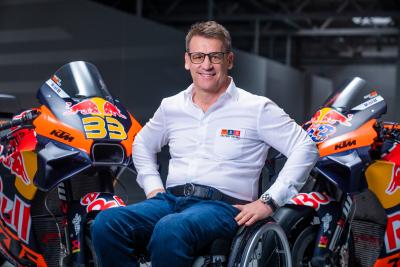KTM: Batteries not the ‘near future’ of motorcycles, against MotoGP hybrids
While the car industry seems to have already committed to an electric future, the weight and range of current battery technology means KTM only views it as viable for scooters and minibikes.
KTM has first-hand experience of electric capabilities through its 'Freeride' off-road bike, but the limited range of current battery technology means it remains a novelty rather than a challenger to combustion power.
“We don’t see that the technology is on the table at the moment to transfer mass production bikes into something like battery [powered] motorcycles,” Beirer said.
“We have a clear commitment to replace smaller engines, like 65cc kids bikes or less than 100cc for urban mobility or around cities with scooters – we see all of this segment as making sense to do it with a battery.
“Everything else, and for what we call a full-size motorcycle from 125cc upwards, we see still the combustion engine as the solution in the near future.”
The MotoGP World Championship reflects the uncertainty within the motorcycling industry by having an electric MotoE World Cup while also transitioning the grand prix classes to 100% non-fossil fuel by 2027 (40% by 2024).
While Ducati has stepped in as MotoE's exclusive bike supplier this season, with the intention to develop future electric road bikes, Beirer sees present battery power as a stop-gap to something else.
Like Triumph's Steve Sargent, Beirer views non-fossil fuel as the best solution for greener grand prix racing in the near future.
“You all know we are pushing like crazy – together with the fuel industry – to get as quickly as possible this sustainable fuel into the [MotoGP] bikes,” Beirer explained.
“Then if you look at a modern motorcycle that is produced with a lot of high-value raw materials… our MotoGP bike is made with 91% recyclable material. You have steel, aluminium and titanium. All raw materials that can and will be reused at the end of the life cycle.
“And if you then fire up [power] the whole project in a short period from now with 20-21 litres of [100%] sustainable fuel, we see the package of the [MotoGP] bike together with the fuel as ready for the future and that’s what we want to stick to.”
For stability, major changes to the MotoGP technical rules are avoided (unless there is unanimous consent) during each five-year contract period between the factories and Dorna.
The current contract runs until the end of 2026, but since manufacturers would want several years of notice to prepare for any major changes in areas such as engine regulations, the key points for the future need to be agreed upon soon.
“In general we feel for racing we still put together a fantastic show for people; they get excited and they want to see these kind of gladiators going out on the racetrack and that is what we have,” he said.
Beirer made clear he would be against MotoGP going down the path of F1 and introducing hybrid engine technology into the premier class.
“With any hybrid then you start to produce batteries, which you have to dig from the ground and take out [elements] that are not available in high quantity and not good for the environment.
“So I feel battery is maybe a transition period [until] there is some future technology that is not ready at the moment for the mass market.”
Note that Beirer ruled out batteries, not electric per se, suggesting he hopes for an alternative future method of storage that avoids the current problems associated with lithium.
KTM is unlikely to feel any 'peer pressure’ over the direction of its future engine technology, having been handsomely rewarded for drawing its own conclusions on where the industry should go in the past.
The Austrian company refused to follow the big Japanese manufacturers in moth-balling two-stroke off-road engines, not only keeping the technology alive alongside its four-stroke models but investing in fuel injection to reduce the engine's biggest problem; emissions.
KTM, plus its sister Husqvarna and GASGAS brands, now dominate the high-end two-stroke market. Other smaller European manufacturers such as Beta and Sherco are also thriving thanks to their range of two-strokes.
Meanwhile, the Japanese factories continue to focus almost exclusively on four-stroke off-road bikes, with only Yamaha responding to the demand from amateur riders - eager for a cheaper, lighter and simpler machine - by offering some modestly updated two-strokes.



![Johann Zarco, LCR, Honda RC213V, 2024 San Marino MotoGP, Misano, action [Gold & Goose]](https://cdn.crash.net/styles/thumbnail/s3/2024-09/GnG_1166323_HiRes.jpg?itok=vpgrU7Q4)

![Jack Miller, KTM Factory Racing, KTM RC16, San Marino MotoGP, Misano, action [Gold & Goose]](https://cdn.crash.net/styles/thumbnail/s3/2024-09/GnG_1167624_HiRes.jpg?itok=iz7mA4EQ)


![Fabio Quartararo, Monster Energy Yamaha Racing, Yamaha M1, 2024 MotoGP, Misano Test, action [Gold & Goose]](https://cdn.crash.net/styles/thumbnail/s3/2024-09/GnG_1168928_HiRes.jpg?itok=fcYSole_)
![Toprak Razgatlioglu, ROKiT BMW Motorrad, BMW M 1000 RR, Magny-Cours, WorldSBK [Gold & Goose]](https://cdn.crash.net/styles/thumbnail/s3/2024-09/GnG_1165133_HiRes.jpg?itok=GD5SVNVG)

